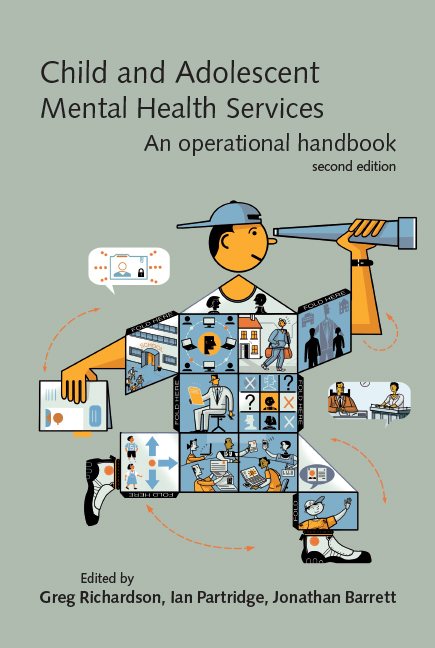Book contents
- Frontmatter
- Contents
- Tables, boxes and figures
- Contributors
- Abbreviations
- Preface
- 1 Introduction
- 2 CAMHS in context
- 3 CAMHS and the law
- 4 Structure, organisation and management of CAMHS
- 5 Evidence-based practice
- 6 Clinical governance
- 7 Education, supervision and workforce development
- 8 Multidisciplinary working
- 9 User and carer participation and advocacy
- 10 A comprehensive CAMHS
- 11 Referral management
- 12 Demand and capacity management
- 13 Strategies for working with Tier 1
- 14 Structuring and managing treatment options
- 15 CAMHS in the emergency department
- 16 Paediatric liaison
- 17 Self-harm
- 18 Learning disability services
- 19 Services for autism-spectrum disorders
- 20 Attentional problems services
- 21 Eating disorder teams
- 22 Bereavement services
- 23 CAMHS for refugees and recent immigrants
- 24 CAMHS and looked-after children
- 25 Drug and alcohol teams
- 26 Parenting risk assessment service
- 27 Court work
- 28 Tier 4 options
- 29 In-patient psychiatric care
- 30 Forensic services
- 31 Neuropsychiatry and neuropsychology services
- 32 Mental health provision for deaf children: study of a low-incidence service provision
- 33 Chief Executives – what do they want and how do they get it?
- Index
7 - Education, supervision and workforce development
- Frontmatter
- Contents
- Tables, boxes and figures
- Contributors
- Abbreviations
- Preface
- 1 Introduction
- 2 CAMHS in context
- 3 CAMHS and the law
- 4 Structure, organisation and management of CAMHS
- 5 Evidence-based practice
- 6 Clinical governance
- 7 Education, supervision and workforce development
- 8 Multidisciplinary working
- 9 User and carer participation and advocacy
- 10 A comprehensive CAMHS
- 11 Referral management
- 12 Demand and capacity management
- 13 Strategies for working with Tier 1
- 14 Structuring and managing treatment options
- 15 CAMHS in the emergency department
- 16 Paediatric liaison
- 17 Self-harm
- 18 Learning disability services
- 19 Services for autism-spectrum disorders
- 20 Attentional problems services
- 21 Eating disorder teams
- 22 Bereavement services
- 23 CAMHS for refugees and recent immigrants
- 24 CAMHS and looked-after children
- 25 Drug and alcohol teams
- 26 Parenting risk assessment service
- 27 Court work
- 28 Tier 4 options
- 29 In-patient psychiatric care
- 30 Forensic services
- 31 Neuropsychiatry and neuropsychology services
- 32 Mental health provision for deaf children: study of a low-incidence service provision
- 33 Chief Executives – what do they want and how do they get it?
- Index
Summary
education n. that which discloses to the wise and disguises from the foolish their lack of understanding.
Ambrose Gwinett Bierce (1842–1914)Introduction
Increased medical advances and a better-informed and more demanding public have put pressure on clinicians both to perform and to show themselves to perform at higher standards than ever before. National standards have been set through National Service Frameworks (NSFs) and by NICE. It is impossible to consider the future direction of education, training and workforce development within CAMHS without reference to two policy documents, the National Service Framework for Children, Young People and Maternity Services (Department of Health, 2004a) and Every Child Matters (HM Government, 2004). Further initiatives for health service staff include Agenda for Change (Department of Health, 2008) and The NHS Knowledge and Skills Framework (Department of Health, 2004b).
The delivery of education and training has changed. Competence and capability as educational outcomes are now valued over qualifications. Practice is linked more closely with education and training, and the competencies required for safe practice are identified through competency frameworks, such as the NHS Knowledge and Skills Framework and postgraduate medical curricula (Child and Adolescent Faculty Further Education and Curriculum Committee, 2008; Royal College of Psychiatrists, 2008). This change has been led by educationalists, clinicians and managers, and is evident in the design of some of the courses that have been developed to address the training gaps highlighted by the requirements of the NSF. The requirement for a capable workforce and the consideration of patient safety as paramount has led to the implementation of workplace-based training and assessment.
Challenges for CAMHS
The children's NSF set challenges for CAMHS, especially to provide services for children with severe learning disabilities, young people aged 16 and 17 years, and to manage emergencies presenting outside normal working hours. Guidance from NICE has presented challenges related to interventions, for example the need to provide CBT for young people with depression (National Collaborating Centre for Mental Health, 2005). The expansion of the workforce in all tiers has put pressure on managers and commissioners to ensure that the workforce has the knowledge, skills and attitudes to work effectively with their client group.
- Type
- Chapter
- Information
- Child and Adolescent Mental Health ServicesAn Operational Handbook, pp. 58 - 68Publisher: Royal College of PsychiatristsFirst published in: 2017

